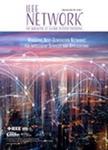版权所有:内蒙古大学图书馆 技术提供:维普资讯• 智图
内蒙古自治区呼和浩特市赛罕区大学西街235号 邮编: 010021

作者机构:Univ Cambridge Comp Lab Cambridge CB2 1TN England
出 版 物:《IEEE NETWORK》 (IEEE Network)
年 卷 期:1998年第12卷第3期
页 面:20-28页
核心收录:
学科分类:0810[工学-信息与通信工程] 0808[工学-电气工程] 08[工学] 0812[工学-计算机科学与技术(可授工学、理学学位)]
主 题:Switches Videoconference Shape control Jacobian matrices Buildings Routing Asynchronous transfer mode Application specific integrated circuits Resource management Protection
摘 要:The Tempest framework provides a programmable network environment by allowing the dynamic introduction and modification of network services at two levels of granularity. First, the switchlet and associated virtual network concepts enable the safe introduction of alternative control architectures into an operational network. The timescales over which such new control architectures can be introduced might vary from, for example, a video conferencing specific control architecture, which is active only for the duration of the conference, to a new version of a general purpose control architecture, which might be active for several months or longer. Second, the Tempest Framework allows refinement of services at a finer level of granularity by means of the connection closure concept. In this case modification of services can be performed at an application-specific level. These attributes of the Tempest framework allows service providers to effectively become network operators for some well defined partition of the physical network. This enables them to take advantage of the knowledge they possess about how the network resources are to be used, by programming their own specially tailored control architecture. This, as our work with the Tempest shows, is a spur to creativity allowing many of the constraints imposed on operators and end users to be rethought and for new techniques to be quickly and safely introduced into working networks.